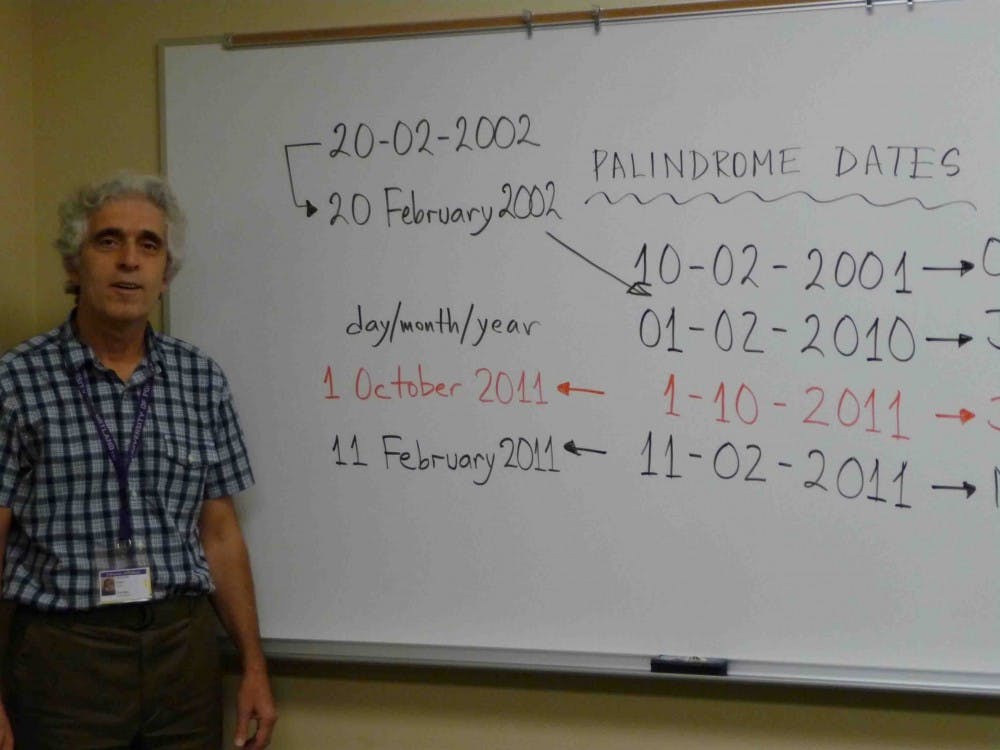If each calendar date in all four-digit years is assigned a single eight-digit full date number as M1M2-D1D2-Y1Y2Y3Y4 (where the first-two digits M1M2 is the month, D1D2 is the day, and Y1Y2Y3Y4 is the year number), some of these dates are palindrome numbers (that is, the date number reads the same forward or backward) and these dates are referred to as palindrome dates. For example, January 2, 2010 this year was the second palindrome date to occur in this century since its full date number is 01-02-2010, a palindrome number.
There are only twelve such eight-digit palindrome dates in the 21st century. The first occurred on October 2, 2001 (10-02-2001) which mostly went unnoticed and the third is next year on November 2, 2011 (11-02-2011). The fourth one is February 2, 2020 (02-02-2020) and so on until the last one on September 2, 2090 (09-02-2090).
Before 2001, the last such palindrome date occurred on August 31, 1380 (08-31-1380) and this confirms the rarity of palindrome dates. Note that this rarity is partly based on each date being represented by an eight-digit date number.
There are some dates in the calendar, however, in which either the month or the day number (or both) is a single-digit number. Months that can be expressed using only single-digit numbers are January through September. Days that can be designated with single-digit numbers are the first nine days of each month. Full date numbers that involve single digit month and/or day numbers can also be represented using seven- or even six-digit numbers instead of eight. For example, Mother Teresa died on September 5, 1997 and this date can be expressed either as 09-05-1997 (eight digits), or 9-05-1997 (seven), or 09-5-1997 (seven), or 9-5-1997 (six).
Interestingly enough, using seven-digit date numbers for some dates introduces many more palindrome dates into the calendar. For example, the last seven-digit palindrome date before this century occurred last century on September 9, 1990 (09-9-1990). In this century, except 2100, a seven-digit palindrome date having single-digit month number occurring in year 20AB have the general form B-A0-20AB where single-digit month number B can take any value between 1 and 9 (January to September). Note that digit A (the tenth digit of the day number) can either be 1, 2, or 3, with one exception, that A cannot equal 3 when B = 2 (February). Based on these, there will be a total of 9 x 3 – 1 = 26 seven-digit palindrome dates with single-digit month number to occur in this century.
It's fascinating that none of these seven-digit palindrome dates have occurred so far; the first is coming up early next year on January 10, 2011 (1-10-2011)! These 26 seven-digit palindrome dates with single month digit are all concentrated between years 2011 and 2039, one to occur in each year, except years 2020 and 2030, and 2032. The second is on February 10, 2012 (2-10-2012), third on March 10, 2013 (3-10-2013), and the last (26th) is on September 30, 2039 (9-30-2039).
Note that no seven-digit palindrome dates having single-digit day number exist in this century since BA-0-20AB is not a valid date number simply because the day number cannot be zero. Also, no six-digit palindrome dates can occur in this century since B-A-20AB cannot be a palindrome number.
It is also interesting to point out that in most other countries the month and the day numbers in a full date number are switched (for example, an eight-digit full date number is written as D1D2-M1M2-Y1Y2Y3Y4) and most of the palindrome dates in this date format are different than the ones in the month-day-year date format. For example, there are twenty-nine eight-digit palindrome dates in the 21st century in day-month-year date format as opposed to twelve in the month-day-year one. This year, 1 February 2010 was a palindrome date (01-02-2010), the third one of the 29 to occur in this century. The first and second were 10 February 2001 (10-02-2001) and 20 February 2002 (20-02-2002). The fourth and fifth will be 11 February 2011 (11-02-2011) and 21 February 2012 (21-02-2012) and so on until the last (29th) one on 29 February 2092 (29-02-2092), a leap day.
In addition to the 29 eight-digit day-month-year palindrome dates, there will be nine seven-digit palindrome dates in the day-month-year date format in this century. All of these nine seven-digit palindrome dates are to be of the form A-10-201A (where each one occurs in October and the single-digit day number A varies between 1 and 9). The first one of these is to occur next year on 1 October 2011 (1-10-2011) and the last (9th) will be 9 October 2019 (9-10-2019). So, one seven-digit day-month-year format palindrome date exists in each year between 2011 and 2019 and none afterwards. Note that the last seven-digit palindrome date in the day-month-year date format before 1 October 2011 occurred last century on 29 September 1992 (29-9-1992). Note also that no seven-digit palindrome dates with single-digit month number exist in this century in the day-month-year date format.
In summary, in the 21st century, there are 12 eight- and 26 seven-digit palindrome dates in the month-day-year date format and 29 eight- and nine seven-digit palindrome dates in the day-month-year date format. Amazingly enough, the total number of eight- and seven-digit palindrome dates in both date formats come out to be the same number, 38! Next year (2011), each date format contains double palindrome dates, 1-10-2011 and 11-02-2011, corresponding to January 10, 2011 and November 2, 2011 in the month-day-year date format and 11 February 2011 and 1 October 2011 in the day-month-year date format. Make sure you book your international travel plans accordingly for 2011 so that you increase the chances of experiencing four palindrome dates!
Aziz Inan is a Professor of Electrical Engineering at University of Portland. He can be contacted at ainan@up.edu
Reference: Aziz Inan, "Twelve Palindrome Dates in 21st Century," The Beacon, November 19, 2009, Vol. 111, No. 11, pp. 11 & 13.








